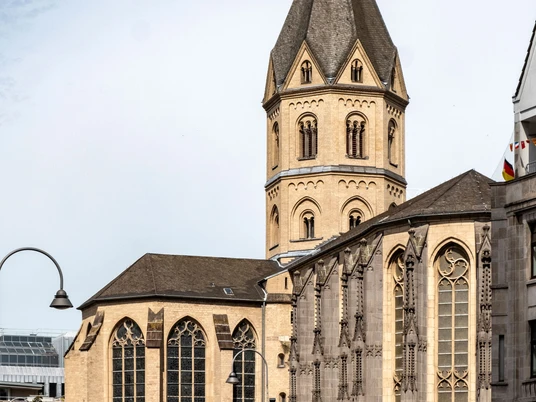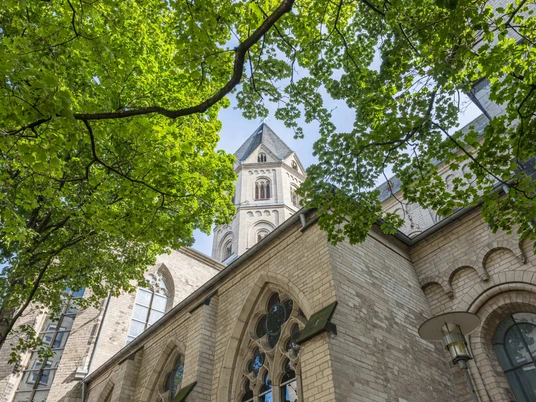- Photos & Map
How would you like to arrive?
- Call
- Details
- Useful Information
- Nearby
With the course of the sun transcendent blue floods the space, gently warm yellow and red tones drift over sacred furniture: Fiat lux. The ancient tradition of stained glass windows in churches continues to this day. Even renowned contemporary artists dare to engage with the magnificent play of light, often created for half an eternity, such as Gerhard Richter—or, for St. Andreas, Markus Lüpertz. When sunlight hits tradition and modernity merge in the timeless experience of the sublime.
St. Andreas is one of the 12 Romanesque churches in Cologne and boasts a history of about 1000 years. Here, not only the Lüpertz windows are considered worth seeing, but also a range of artifacts—aside from the actual church building and its history.
You might also notice the fountain in the entrance hall: It dates from the 16th century and allegedly collected the blood of the eleven thousand virgins from St. Ursula's entourage as the so-called Blood Fountain.
Around 1200, St. Andreas, as a new three-aisled pillar basilica with a westwork, crossing tower, and long choir, replaced an older church. Like the other 12 Romanesque churches in Cologne, subsequent centuries were marked by alterations and redesigns: In the 13th/14th centuries, for example, Gothic features expanded the church building. Other elements remained, such as parts of the original 11th-century crypt: It was filled during the 14th century and only rediscovered and excavated after World War II. Here lie the remains of the famous Saint Albertus Magnus—a doctor universalis. Definitely, go down there.
Despite the destructions of World War II, St. Andreas was sufficiently restored by 1947, and the brothers of the Dominican order took over the pastoral care. In the following years, the crypt was excavated and expanded with a tomb chapel for the Dominican Albertus Magnus. Since 2005, a series of modern stained glass windows have been created according to the designs of Markus Lüpertz, giving St. Andreas new luster.
Since 2020, additional windows have been added—11 more are planned for the nave and church porch. In 2020, the Peter of Milan window was installed—Peter of Milan was also the patron saint of Cologne brewers; the Joseph window and the Baptism window followed in 2022.
In 2023/2024, the Resurrection window, the Annunciation window, and the Presentation of the Rosary were added. Lüpertz sees in his work a heartfelt task, great responsibility, and a contribution to the preservation of glass art that "opens the eyes." Whether in the ecclesiastical or architectural sense: Enlightenment is guaranteed in St. Andreas.
St. Andreas is one of the 12 Romanesque churches in Cologne and boasts a history of about 1000 years. Here, not only the Lüpertz windows are considered worth seeing, but also a range of artifacts—aside from the actual church building and its history.
Shrine, Figures, Triptych, Fountain of Blood & More
St. Andreas has an exceptionally rich collection dating from the 15th and 16th centuries that you can visit: Notable are the choir stalls from around 1430, which, along with those in St. Gereon and Cologne Cathedral, are among Cologne's most significant medieval works. Or the wooden figure of St. Christopher from the workshop of Master Tilman, dated to the last decade of the 15th century, as well as the Rosary Madonna triptych from the workshop of the Master of St. Severin. In the Maccabee Choir stands the late medieval gilded Maccabee Shrine decorated with relief panels.You might also notice the fountain in the entrance hall: It dates from the 16th century and allegedly collected the blood of the eleven thousand virgins from St. Ursula's entourage as the so-called Blood Fountain.
On History and Construction
Characteristic of the Romanesque church St. Andreas is the stylistic connection between Romanesque and Gothic: Rich, ornamental architectural elements of the Romanesque exist alongside elements of simple Gothic elegance, such as the late Gothic choir hall. Thus, you can experience styles from several centuries in one space.Around 1200, St. Andreas, as a new three-aisled pillar basilica with a westwork, crossing tower, and long choir, replaced an older church. Like the other 12 Romanesque churches in Cologne, subsequent centuries were marked by alterations and redesigns: In the 13th/14th centuries, for example, Gothic features expanded the church building. Other elements remained, such as parts of the original 11th-century crypt: It was filled during the 14th century and only rediscovered and excavated after World War II. Here lie the remains of the famous Saint Albertus Magnus—a doctor universalis. Definitely, go down there.
Despite the destructions of World War II, St. Andreas was sufficiently restored by 1947, and the brothers of the Dominican order took over the pastoral care. In the following years, the crypt was excavated and expanded with a tomb chapel for the Dominican Albertus Magnus. Since 2005, a series of modern stained glass windows have been created according to the designs of Markus Lüpertz, giving St. Andreas new luster.
The Landmark Project: Lüpertz Windows
Between 2005 and 2010, in the two transepts, the Marian and Maccabee Choir, 12 windows were created based on Markus Lüpertz's designs, telling stories of, among others, the Passion of Christ, the martyrdom of the Maccabees, and Albertus Magnus.Since 2020, additional windows have been added—11 more are planned for the nave and church porch. In 2020, the Peter of Milan window was installed—Peter of Milan was also the patron saint of Cologne brewers; the Joseph window and the Baptism window followed in 2022.
In 2023/2024, the Resurrection window, the Annunciation window, and the Presentation of the Rosary were added. Lüpertz sees in his work a heartfelt task, great responsibility, and a contribution to the preservation of glass art that "opens the eyes." Whether in the ecclesiastical or architectural sense: Enlightenment is guaranteed in St. Andreas.
Useful Information
Eligibility
Bad Weather Offer
Suitable for any weather
for Groups
for families
for individual guests
Suitable for the Elderly
Openings
Payment methods
Entrance Free
Parking facilities
Approximately 300 metres on foot from Cologne Cathedral and the main railway station
General information
Parking Available
Bus stop available
Nearby

